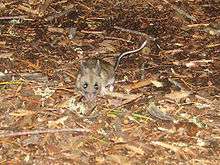White-footed mouse
| White-footed mouse | |
|---|---|
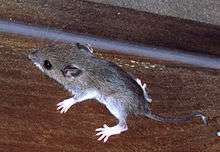 | |
| Scientific classification | |
| Kingdom: | Animalia |
| Phylum: | Chordata |
| Class: | Mammalia |
| Order: | Rodentia |
| Family: | Cricetidae |
| Subfamily: | Neotominae |
| Genus: | Peromyscus |
| Species: | P. leucopus |
| Binomial name | |
| Peromyscus leucopus (Rafinesque, 1818) | |
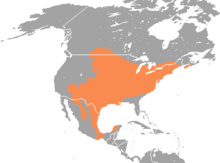 | |
The white-footed mouse (Peromyscus leucopus) is a rodent native to North America from Ontario, Quebec, Labrador, and the Maritime Provinces (excluding the island of Newfoundland) to the southwest United States and Mexico.[1] In the Maritimes, its only location is a disjunct population in southern Nova Scotia.[2] It is also known as the woodmouse, particularly in Texas.
Description
Adults are 90–100 mm (3.5–3.9 in) in length, not counting the tail, which can add another 63–97 mm (2.5–3.8 in). A young adult weighs 20–30 g (0.7–1.1 oz). While their maximum lifespan is 96 months, the mean life expectancy for the species is 45.5 months for females and 47.5 for males. In northern climates, the average life expectancy is 12–24 months.[3]
Behavior and diet
White-footed mice are omnivorous, and eat seeds and insects. It is timid and generally avoids humans, but they occasionally take up residence in ground-floor walls of homes and apartments, where they build nests and store food.[4]
Similar species
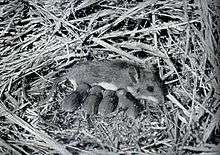
This species is similar to Peromyscus maniculatus. Like the deer mouse, it may carry hantaviruses, which cause severe illness in humans.[5]
Connection to Lyme Disease
It has also been found to be a competent reservoir for the Lyme disease-causing spirochete, Borrelia burgdorferi.[6]
See also
References
- 1 2 Linzey, A.V.; Matson, J. & Timm, R. (2008). "Peromyscus leucopus". IUCN Red List of Threatened Species. Version 2009.2. International Union for Conservation of Nature. Retrieved 5 February 2010.
- ↑ Atlantic Interior, The Natural History of Nova Scotia
- ↑ Mammalian models for research on aging (1981) ISBN 978-0-309-03094-6
- ↑ "WHITE-FOOTED AND DEER MICE". The Internet Center for Wildlife Damage Management. Retrieved 9 June 2016.
- ↑ RR5109-Front Cover-Hantavirus.p65
- ↑ Donahue JG, Piesman J, Spielman A (January 1987). "Reservoir competence of white-footed mice for Lyme disease spirochetes". Am. J. Trop. Med. Hyg. 36 (1): 92–6. PMID 3812887.
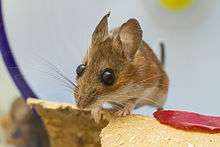
Bibliography
- Anderson JF, Johnson RC, Magnarelli LA (1987) Seasonal prevalence of Borrelia burgdorferi in natural populations of white-footed mice, Peromyscus leucopus. J Clin Microbiol ; 25:1564–1566
- Anita Rogic, Nathalie Tessier, Pierre Legendre, François-Joseph Lapointe, Virginie Millien (2013) Genetic structure of the white-footed mouse in the context of the emergence of Lyme disease in southern Québec. Ecology and Evolution 3:7, 2075-2088, mis en ligne 1er juillet 2013 (résumé)
- Barthold, SW, Persing, DH, Armstrong, AL, Peeples, RA. (1991) Kinetics of Borrelia burgdorferi dissemination and evolution of disease after intradermal inoculation of mice. Am J Pathol ; 139:263–273
- Bunikis J, Tsao J, Luke CJ, Luna MG & al. (2004) Borrelia burgdorferi infection in a natural population of Peromyscus leucopus mice: a longitudinal study in an area where Lyme borreliosis is highly endemic. J Infect Dis ; 189:1515–1523
- Brunner JL, LoGiudice K & Ostfeld RS (2008) Estimating reservoir competence of Borrelia burgdorferi hosts: prevalence and infectivity, sensitivity, and specificity. J Med Entomol ; 45:139–147
- Burgess EC, French JrJB & Gendron-Fitzpatrick A. (1990) Systemic disease in Peromyscus leucopus associated with Borrelia burgdorferi infection. Am J Trop Med Hyg ; 42:254–259
- Goodwin BJ, Ostfeld RS & Schauber EM (2001) Spatiotemporal variation in a Lyme disease host and vector: black-legged ticks on white-footed mice. Vector Borne and Zoonotic Diseases, 1(2), 129-138.
- Hofmeister EK, Ellis BA, Glass GE & Childs JE (1999) Longitudinal study of infection with Borrelia burgdorferi in a population of Peromyscus leucopus at a Lyme disease-enzootic site in Maryland. Am J Trop Med Hyg ; 60:598–609
- Horka H, Cerna-kyckovaa K, Kallova A & Kopecky J (2009) Tick saliva affects both proliferation and distribution of Borrelia burgdoferi spirochetes in mouse organs an increases transmission of spirochetes by ticks. Int J Med Microbiol ; 299:373–380
- Martin LB, Weil ZM, Kuhlman JR & Nelson RJ (2006) Trade-offs within the immune systems of female white-footed mice, Peromyscus leucopus. Funct Ecol ; 20:630–636.
- Martin LB, Weil ZM & Nelson RJ (2007) Immune defense and reproductive pace of life in Peromyscus mice. Ecology ; 88:2516–2528
- Ostfeld RS, Miller MC & Hazler KR (1996) Causes and consequences of tick (Ixodes scapularis) burdens on white-footed mice (Peromyscus leucopus). J Mammal ; 77:266–273.
- Ostfeld RS, Schauber EM, Canham CD, Keesing F & al. (2001) Effects of acorn production and mouse abundance on abundance and Borrelia burgdorferi infection prevalence of nymphal Ixodes scapularis ticks. Vector Borne Zoonot Dis ; 1:55–63
- Pederson AB, Grieves TJ (2008) The interaction of parasites and resource cause crashes in wild mouse population. J Anim Ecol ; 77:370–377
- Schwan, TG, Burgdorfer, W, Schrumpf, ME, Karstens, RH. (1988) The urinary bladder, a consistent source of Borrelia burgdorferi in experimentally infected white-footed mice ( Peromyscus leucopus). J Clin Microbiol ; 26:893–895 (PDF, 4 pp).
- Schwan TG, Kime KK, Schrumpf ME, Coe JE et al. (1989) Antibody response in white-footed mice (Peromyscus leucopus ) experimental infected with the Lyme disease spirochete (Borrelia burgdorferi). Infect Immunol ; 57:3445–3451
- Schwanz LE, Voordouw MJ, Brisson D& Ostfeld RS (2011) Borrelia burgdorferi has minimal impact on the Lyme disease reservoir host Peromyscus leucopus ; Vector-borne and zoonotic diseases, 11(2), 117-124
External links
- White-footed Mouse, State University of New York, College of Environmental Science and Forestry
- White-footed Mouse, CanadianFauna.com
- White-footed Mouse, Canadian Biodiversity Website


